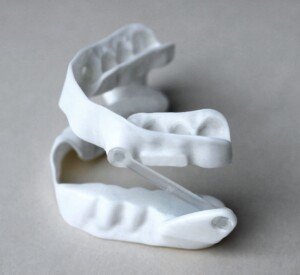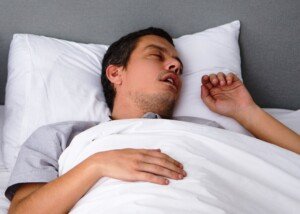
Seems that a mandibular advancement device (MAD) would keep the airway open continuously, yet this oral appliance is no match for CPAP when it comes to obstructive sleep apnea of moderate to severe degree.
Oral appliances, including the tongue advancement device, can eliminate obstructive sleep apnea in mild cases.
They are not recommended in severe and even moderate OSA cases.
Obviously, despite an oral appliance, the airway continues to collapse in moderate to severe cases, making the device ineffective and CPAP the only recourse.
“The oral devices usually either advance the tongue or the jaw,” says Dale Rice, MD, professor of otolaryngology-head and neck surgery, Keck School of Medicine USC.
“The real problem for most people is the soft palate which these devices do not really address,” continues Dr. Rice.
“Almost everyone with OSA has an elongated soft palate, and none of these devices shorten the palate or pull it forward. CPAP works because it merely blows the palate out of the way while surgery shortens it.”
The MAD often works for mild cases of obstructive sleep apnea because the number of disordered-breathing events that the mandibular advancement device eliminates, puts the AHI in the medically acceptable range.
In moderate OSA, the oral appliance would reduce the AHI, but the AHI would still be in the OSA range, albeit perhaps no longer moderate – but now mild.
Well, if it’s mild with a MAD, then the situation is not resolved. This patient needs a CPAP machine.
Example of How this Works
AHI stands for apnea-hypopnea index. If a sleep study result yields an AHI of eight, this means you averaged eight disordered-breathing events per hour.
• Mild sleep apnea: 5-15 AHI
• Moderate: 16-30 AHI
• Severe: AHI of 31+
A mandibular or tongue advancement device might take an AHI of 12 down to three. This means an elimination of the criteria for sleep apnea.
In someone with an AHI of, say, 20, the oral appliance might prevent an average of nine events per hour, such as in the above case. However…20 minus 9 equals 11.
That’s a new AHI of 11. The patient STILL has sleep apnea, though now in the mild range.
This is precisely why oral appliances are recommended only for mild OSA cases and do not work for severe and even moderate cases.
A second sleep study is required to verify that a MAD or tongue device works on a mild case. If not, then CPAP is urged.

 Dr. Rice’s
Dr. Rice’s























